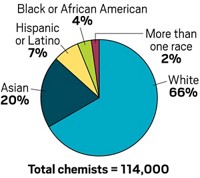Advertisement
Grab your lab coat. Let's get started
Welcome!
Welcome!
Create an account below to get 6 C&EN articles per month, receive newsletters and more - all free.
It seems this is your first time logging in online. Please enter the following information to continue.
As an ACS member you automatically get access to this site. All we need is few more details to create your reading experience.
Not you? Sign in with a different account.
Not you? Sign in with a different account.
ERROR 1
ERROR 1
ERROR 2
ERROR 2
ERROR 2
ERROR 2
ERROR 2
Password and Confirm password must match.
If you have an ACS member number, please enter it here so we can link this account to your membership. (optional)
ERROR 2
ACS values your privacy. By submitting your information, you are gaining access to C&EN and subscribing to our weekly newsletter. We use the information you provide to make your reading experience better, and we will never sell your data to third party members.
Careers
Understanding Diversity
NSF hopes to support, encourage social research on minorities in science
by David Pittman
November 22, 2010
| A version of this story appeared in
Volume 88, Issue 47

Since its founding in 1992, the Biology Scholars Program (BSP) at the University of California, Berkeley, has served more than 2,000 undergraduates. The program was created to encourage and nurture underrepresented minorities and low-income and first-generation college students—demographics that often struggle with or drop out of the sciences in school.
In the past 18 years, greater than 80% of the program’s students have been accepted to medical school, compared with a little more than 50% of Berkeley’s overall biology students not in the program. More than 90% of black BSP students graduate, compared with about 75% of all black Berkeley students.
The success lies, BSP’s organizers believe, in showing the impact that science can have on society and what part the students can play in changing the future. “I don’t necessarily have evidence to be able to support this, but this is my working hypothesis,” BSP Director and cofounder John Matsui says.
Berkeley’s BSP is an obvious example of a successful diversity program. But too often the reason why such efforts succeed—or not—in having an effect on students is not well understood. Explanations are almost always anecdotal, given with little or no scientific review.
To provide a sound basis for evaluating diversity programs, the National Science Foundation is considering a new social sciences program that would support research to understand the progress of and barriers to minority achievement in science and engineering.
Such work is now only sparsely supported by NSF and is not unified under a single program. By consolidating the research, NSF administrators believe, the agency can increase financial support, generate more interest in the topic, spur collaborations, and better corral and broadcast new findings. If scientists can figure out how and why certain programs work, NSF reasons, the results can be applied with better success to all science, technology, engineering, and mathematics fields, which have struggled to retain black and Hispanic students.
Because a program doesn’t yet exist, NSF is sending a “Dear Colleague” letter to social sciences researchers this month soliciting research proposals on diversity issues. “The intention is to get a response that is so heavy that we could justify establishing a new program, but that’s down the road,” says Kellina Craig-Henderson, program director for the Behavioral & Cognitive Sciences Division at NSF.
If the solicitation generates enough interest, the Science of Broadening Participation program would operate under the Social, Behavioral & Economic Sciences Directorate and the Division of Behavioral & Cognitive Sciences. It would seek proposals on how to increase the numbers of underrepresented minorities—blacks, Hispanics, and Native Americans—and women studying science and in the scientific workforce.
“There remain quite a few questions that have not been addressed by investigators,” Craig-Henderson says. “We think that the social sciences are especially well suited to be able to answer these questions, given the research methods they use and the kinds of questions they typically ask.”
For example, research in the American Sociological Review has indicated that diversity training doesn’t increase diversity in senior management (2006, 71, 589). And in another study in the American Journal of Sociology, investigators have found that the likelihood of segregated friendships increases as a school’s racial diversity increases (2001, 107, 679).
“Research has provided a detailed description of where women and ethnic and racial minorities fall out of the career system in the various sciences,” says Harvard University sociologist Frank Dobbin, who studies diversity management and equal-opportunity programs. “But we know almost nothing about what kinds of efforts to stop this leakage and promote diversity have been successful.”
What is known is that increasing the participation of underrepresented minorities and women in science has been difficult. White men hold three of every four faculty jobs in the top 100 U.S. chemistry departments, as ranked by research budgets, according to a 2010 report entitled “A National Analysis of Minorities in Science and Engineering Faculties at Research Universities” by University of Oklahoma, Norman, chemistry professor Donna J. Nelson. Minorities and women make up less than 4% and 14% of their faculties, respectively, Nelson finds.
“In most disciplines, underrepresented minorities are so few that a minority student can get a B.S. or Ph.D. without being taught by or having access to an underrepresented minority in that discipline,” Nelson writes in her 2010 report. “Minorities are less likely to enter and remain in science and engineering when they lack mentors and role models.”
According to a National Academies study released in late September, “Expanding Underrepresented Minority Participation,” the minority population, which makes up 29% of the country, receives less than 15% of science and engineering master’s degrees and 5% of doctorates.




Join the conversation
Contact the reporter
Submit a Letter to the Editor for publication
Engage with us on Twitter